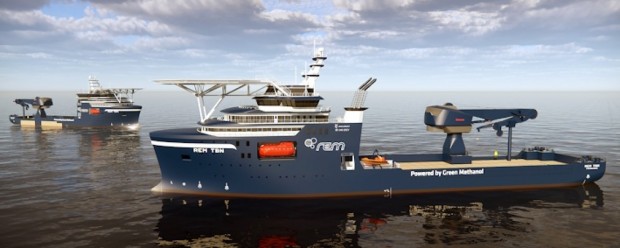Pioneering a new era in offshore construction, the ESCV emerges as a trailblazer in offshore operations, promising versatility and sustainability. Its pioneering design will reportedly enable it to carry out heavy construction tasks effortlessly in offshore wind farms and subsea environments while boasting zero emissions.

(Photo : Marimit Magasin/Skipsteknisk )
Sustainability of the Construction Vessel
A contract has been finalized between Rem Offshore and Myklebust Verft regarding the utilization of a 250-tonne crane in the construction of an Energy Subsea Construction Vessel (ESCV). Once completed in 2026, the vessel will be the inaugural capable of conducting substantial construction operations subsea and offshore while producing zero net emissions. The contract also includes an option to construct one additional vessel.
As mentioned, this construction vessel is planned to be outfitted with battery packs in addition to dual-fuel methanol engines. All offshore hoisting equipment, including the 250 T crane, supplies the batteries with electrical power. Along with its 1,400 m2 working area, the superstructure has the necessary infrastructure to accommodate an offshore gangway designed for offshore wind usage.
Moreover, Skipsteknisk has developed an extremely adaptable platform after working closely with Rem and Myklebust. Beyond achieving future demands for zero emissions from beginning to end, the innovative new building employs several solutions that reduce energy consumption by nearly half compared to comparable tonnage today.
Conradi Andersen, CEO of Rem Offshore, stated that Myklebust Verft was an intuitive choice since the company has previously provided Rem with new builds. Thus, Rem Offshore has reportedly made considerable progress. The company is taking a significant step into the future by ordering its first net-zero emission vessel. Customers will value the opportunity for more sustainable and efficient operation. Accordingly, Rem Offshore eagerly awaits the vessel's introduction to the market.
On the other hand, Brunvoll will provide a thruster package that includes a tunnel thruster, two retractable azimuth thrusters, and two propulsion azimuth thrusters combined into one. When the thruster is in its retracted configuration, it performs the same function as a tunnel thruster. This retractable azimuth thruster is a newly created and more compact variant of Brunvoll's classic azimuth combi thrusters. Brunvoll asserts that the freshly developed combi thruster design substantially reduces building height by employing a comparable mechanism for lowering and retracting, as observed in non-combi units. Furthermore, the design enhances efficiency when in the retracted position.
Also Read: Dive into Diversity: Exploring 8 Distinct Styles of Inground Pools
Brunvoll Expertise on Vessels
One of the most prominent providers of maritime systems, Brunvoll is a subsidiary of Brunvoll Holding AS. Propulsion, positioning, and maneuvering systems for modern ocean-going vessels are provided by the company, which has extensive expertise in designing, developing, in-house production, and service of these systems. In addition to having a high export share and solid financial stability, Brunvoll is a Norwegian company owned and operated by a family. In 2023, the group achieved a turnover of around 1.5 billion Norwegian Krone, indicating it is undergoing robust expansion.
As mentioned, Brunvoll's mission statement is 'Trusted WorldWide,' the company's core principles include being responsible, dependable, and devoted members of society. Since its founding in 1912, the company has expanded to include approximately 560 people across Norway, with offices in Molde, Volda, Ålesund, Porsgrunn, and Dalen. In over 20 nations worldwide, Brunvoll is represented by a sales and service network.
Related Article: Georgia Tech's New Athletic Performance Center Embraces Sustainable Construction







